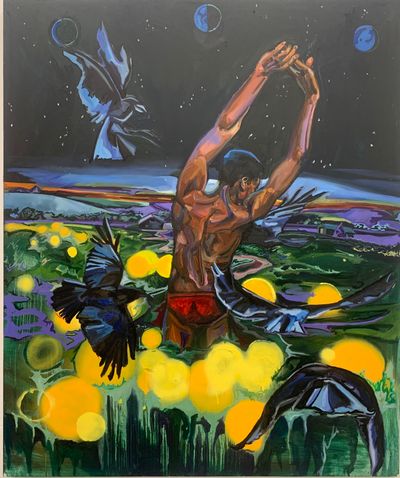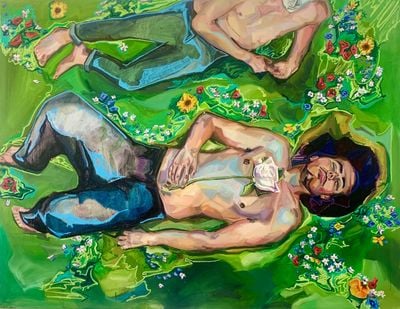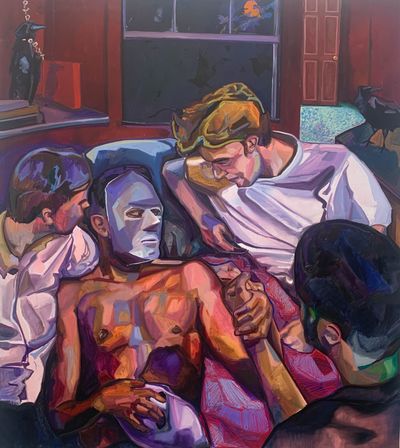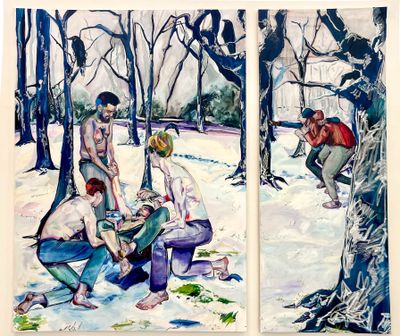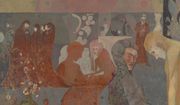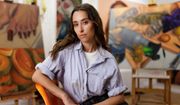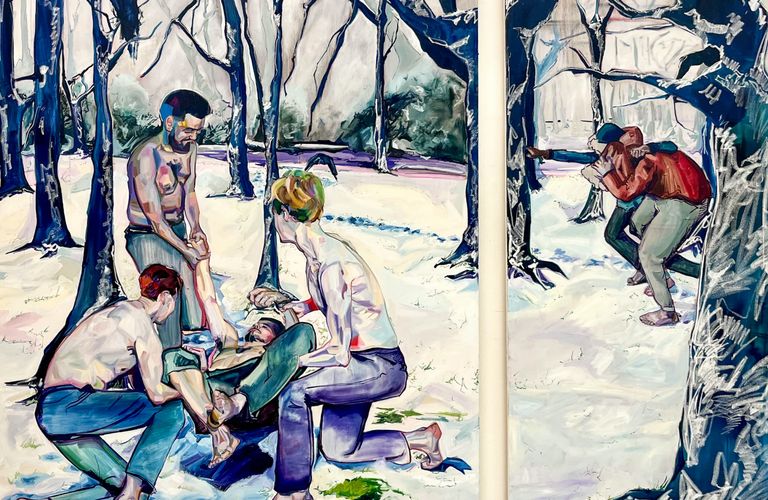
Shaqúelle Whyte relocated to London in 2018 to begin his studies at the Slade, graduating this year. Interest in his work by gallerists and private collectors is already mounting, and it's easy to see why.
Expressive brushstrokes and alluring colours make up emotive character studies. His paintings have a filmic quality, with subjects engaged in ambiguous narratives, such as the drama unfolding between figures in the snow-covered woods in I can see and I don't like it (2022).
In this interview, Whyte speaks with Ocula Advisory's Rory Mitchell about the challenges faced by young painters finishing art school today, his key influences, and the new directions he wishes to take in his work.
Could you tell me about what led you to the Slade? Were you at a school that supported art?
My art teacher, Ms Cameron, gave me the agency to develop my work. The classes I had before hers were really curriculum and grades-based, but Ms Cameron was trying to do more than that. She pushed me to work more with what I was doing then.
I was also very involved in music at school, performing in a jazz band. My music teacher, Mr Howard, and his wife Mrs Howard created a system of kinship and creativity. And when the art started taking over the music for me, they were very supportive of that.
Then you went straight to the Slade?
That was honestly by accident. The only reason I knew about the Slade was because I went to the university's summer school. It was a friend of mine who recommended it.
My teacher told me not to do a foundation, and I researched a little bit and felt it was a non-starter, so I just applied to go straight in. I wouldn't recommend that people skip a foundation, though, as it allows you to dip your toes in everything.
I was at a uni where people were self-assured and knew exactly what the Slade was about. I was insecure about my practice. Coming to London from Wolverhampton was a big change. In the first year, I felt dissociated from what I had been doing at A level, and I stopped painting for a year and dabbled with film.
In the second year, I started painting again, but my first crit was an absolute assault on my practice—I got told that I couldn't draw. I needed to hear that, because it made me thicker skinned.
That second year at the Slade was probably one of the most important years I've had, but it broke me a bit. Art school doesn't teach you how to paint; it teaches you how to think. So everyone has different drawing abilities.
I spent the year trying to spend time figuring out what that meant. In some ways I think he was right; I was preaching about this idea of painting people's truth, but I was so involved in what I was portraying that what I had was confused—something was off. There were too many dichotomies breaking up the piece.
What I realised in a really good tutorial with Michael Armitage was that I wasn't painting people—I was painting myself and using the paintings as anchors to drive forward an idea. And that's how I developed my idea of treating paintings as devices to mobilise different ideas.
Through the Slade I've had access to tutorials by artists like Michael Armitage, Rachel Jones, Jadé Fadojutimi, and Alvaro Barrington. These are the UK's leading artists.
Some of them have found success very quickly, so it's also interesting for students to talk to them about that, because it's such a different landscape for artists coming out of university now rather than ten years ago.
Absolutely. For me it started happening during the pandemic. I exhibited work as part of a collective, and that was an amazing experience. My friend Lawrence Perry alerted me to a residency that was happening at the Columbia Hotel in collaboration with Roman Road, and I applied and got it!
There was a show at the end of it, and from there I met the person whose been the most supportive to my practice, Katy Wickremesinghe. Through meeting her I met people like Brandei Estes and Daniel Raphael.
Some people have come to see my work in person after having seen it online, which has been pleasant surprise—there's a different translation that happens there.
That's not just as a result of Covid-19, but also how people use Instagram now, for example, as a tool to discover work.
There is more of a demand from the market for work by artists coming straight out of art school and there are younger galleries. There's even more pressure on younger artists, and it's scary because what you do early on impacts your future.
In Michael Armitage's work, you can see that he's pushing himself to develop how he describes things and how he tells stories and uses art history to portray something.
It's so different now, for artists coming out of art school. Michael Armitage's progress was much steadier—it's different for you guys. It must feel a bit crazy sometimes.
Yes. Doron Langberg and Salman Toor, Jadé Fadojutimi, Rachel Jones, Jennifer Packer, and Lynette Yiadom-Boakye are all artists that I admire and who have risen to prominence. I went to Lynette's Tate show twice on my own and once with my mum.
I've got this paining of a snow scene, which is called I can see and I don't like it. It was influenced by Peter Doig, Murakami, but also Lynette Yiadom-Boakye, because she has this painting of a guy whose got flowers by his feet, and it's completely white. The way that she paints it white is just so phenomenal.
I was also looking to Jadé's second solo exhibition with Pippy Houldsworth Gallery where she has this white painting, which was my favourite painting in the show—it's just humming. The way the paint sort of slides through itself—there are thinner bits, built-up bits.
I don't want to make ignorant work. And by that, I mean work that's not considered. I don't think you're ignorant if you don't think about what you're making, but for me it's about where I came from, and the potentials of a Black male painter.
One of my favourite painters when I got to Slade was Kehinde Wiley. At A Level I was thinking a lot about Black activism in England, and I felt that he is painting for community. Then I got to uni and I was introduced to painters like Jennifer Packer, Kudzanai-Violet Hwami, Hurvin Anderson, and Kerry James Marshall.
I got to see the breadth of Blackness in art. Because we've been part of art history for thousands of years, but it's only between the last 15-20 years that people are buying off the continent, as promoted by platforms such as 1-54.
I now understand that you can service a community through art, which is what Kehinde Wiley does. When he painted a picture of Barack Obama, it wasn't just for Black Americans, it was for Black kids over here too.
For the moment, I'm trying to figure out my own politics. That level of servicing a whole community, where it's so explicitly about Blackness, I don't think I could do that. I know that my politics will come into my work very explicitly at some point, but I just need to paint a bit about me, and that includes Blackness, but also so many other things.
When I find something to say that is then placed in the context of these amazing painters, it needs to be done right.
In this particular painting, I can see and I don't like it, I can see the influence of painters like Doig, but it's also got a filmic quality.
I thought about Lord of the Flies a lot. I like to create this feeling that you're stepping into the scene, and you can imagine standing in the snow with them.
One of my favourite artists is Philip-Lorca diCorcia. What he photographs is much more about capturing specific environments, and this is something I want to push more in the work.
One of the first things I was told when I was learning to paint was not to use black, and that's something I try not to do, because you can find so many other alternatives for darker shades. It's the reason I feel like the worlds I'm creating are my own, because skin is whatever I can make it to be.
It's painting; I'm not trying to replicate real life. If that was the point, I'd take a photograph. What I'm trying to do is paint an environment, and most importantly, a feeling, and a variety of different feelings in some cases.
With a language that you are developing, you can create these things that fit within a reason of why you are making them, but that can infinitely change as you grow. You gotta make the work and then be critical afterwards—those are two different entities. You can't do them at the same time.
You need an instinctiveness and impulse while you're painting, otherwise you lose the flow.
Exactly. While painting, you're trying to make the unconscious, conscious. With this degree show, what's being presented is what I do now, but I'm already trying to break apart and move forward with it, while looking to the work of other artists. There's a way that you can feel invigorated through that.
There are fragments of these paintings that remind me of other figurative painters, but something that I look for in a young artist is a unique style, so that when I see the works, I immediately recognise them. You definitely have that.
In this world I've been trying to build, I've got this tiny bit of land where I can say for sure that this bit of land is mine.
I realise my work has a lot of commas and exclamation points, which is amazing, but I want to paint more full stops. And that doesn't need to be big pieces, it can be small moments. For example, Jennifer Packer, she paints these figurative portraits, but then the smaller ones that are full stops are the still-lifes—that's her finding her full stop. —[O]
Main image: Shaquelle Whyte, I can see and I don't like it (2022) (detail). Courtesy the artist.


